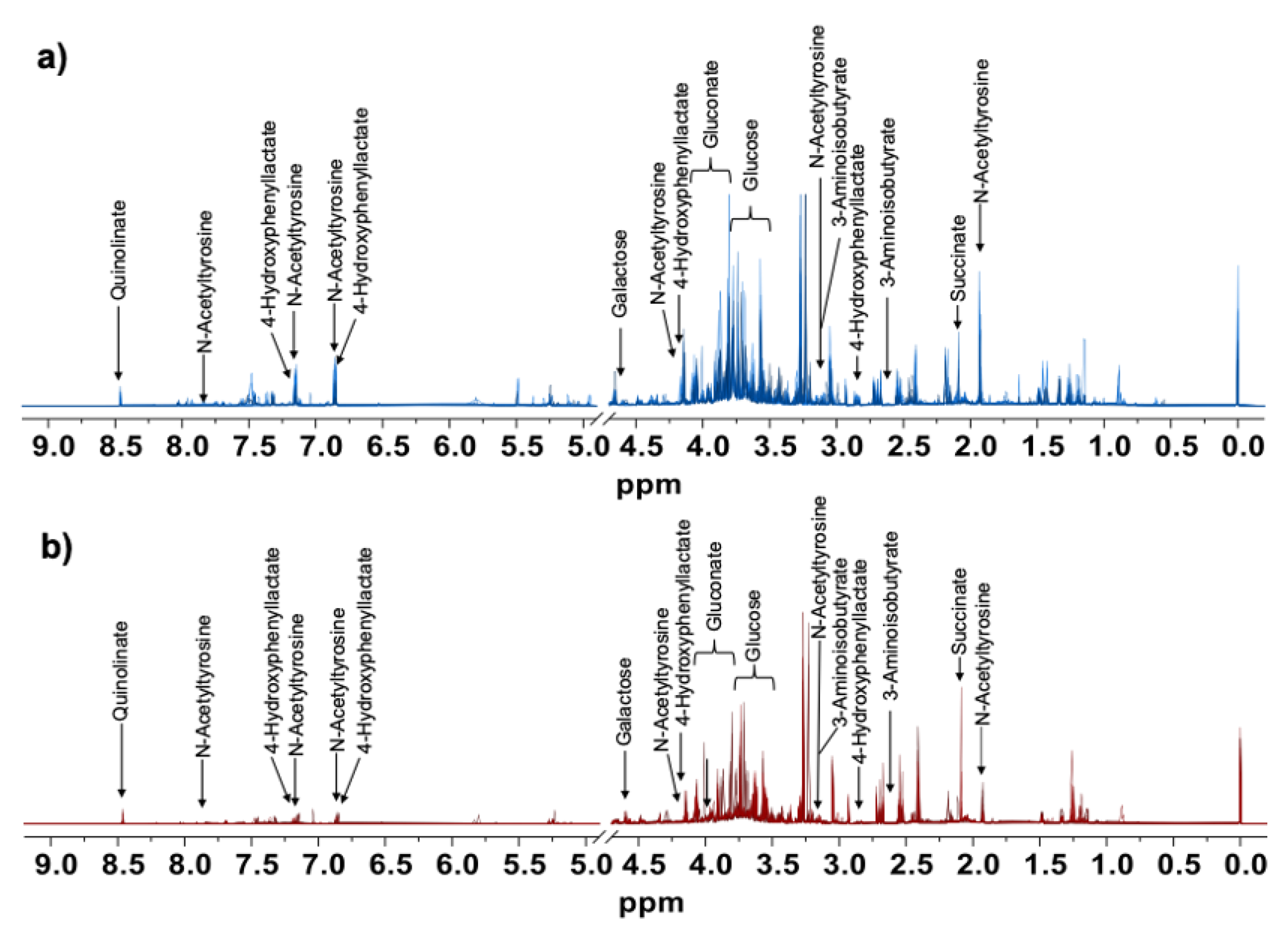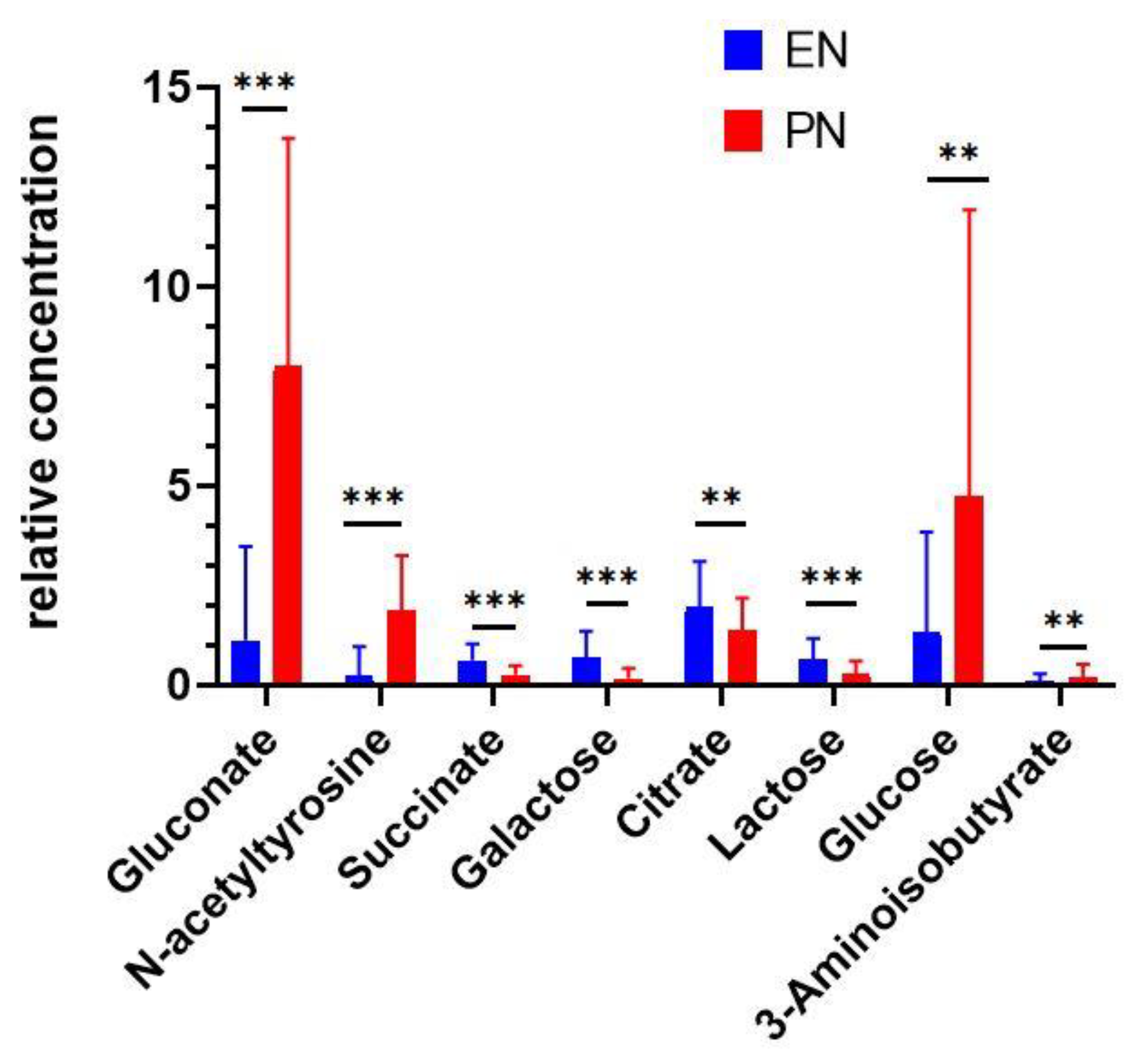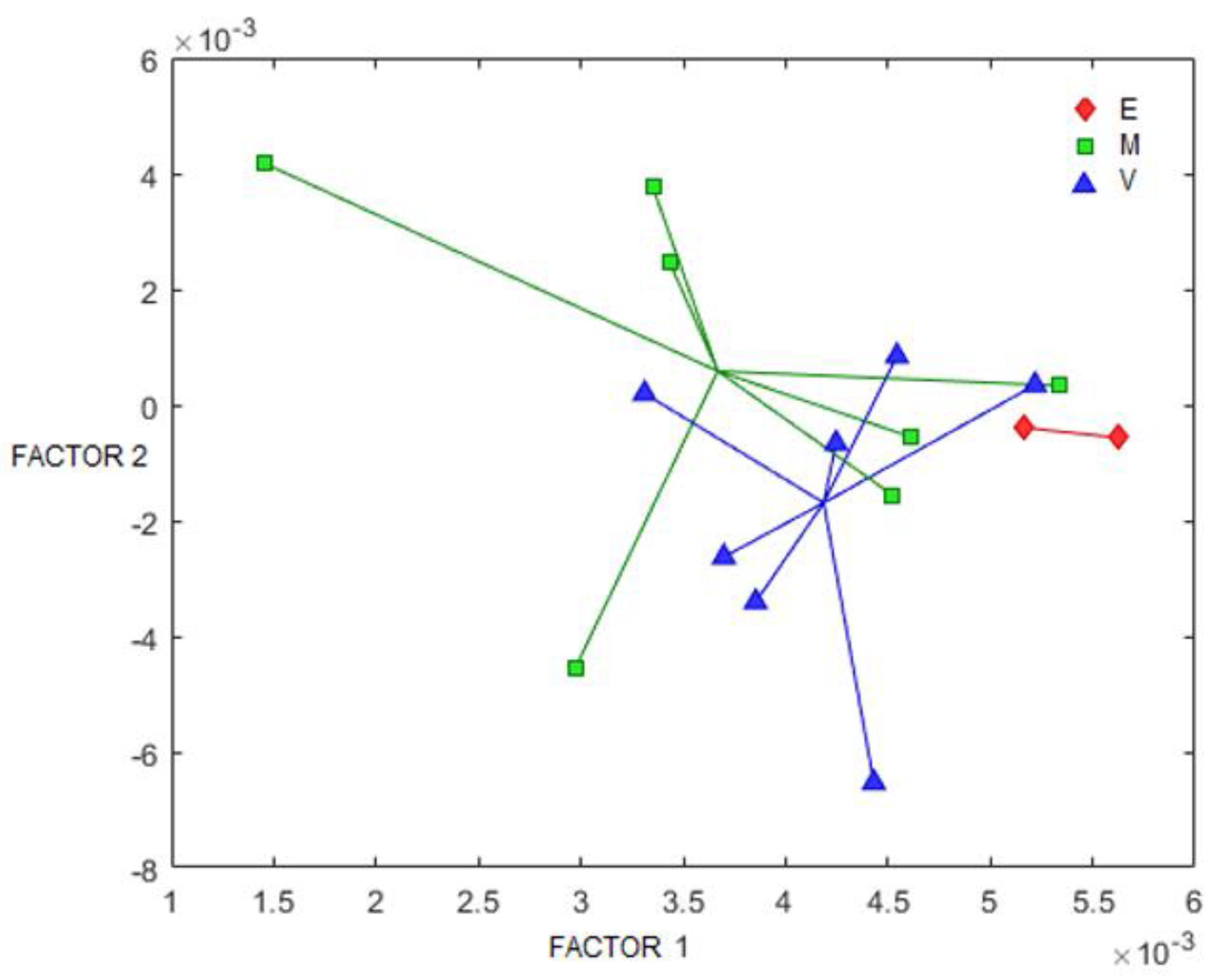A Longitudinal 1H NMR-Based Metabolic Profile Analysis of Urine from Hospitalized Premature Newborns Receiving Enteral and Parenteral Nutrition
Abstract
:1. Introduction
2. Results
2.1. Patients and Samples
2.2. Metabolomic Profile Analysis by PCA and OPLS-DA
2.3. Interpretation of the Involved Metabolic Pathways
2.4. Metabolomic Profiles by Parallel Factor Analysis (PARAFAC-2)
3. Discussion
4. Materials and Methods
4.1. Ethics Statement
4.2. Patients and Sampling
4.3. PN or EN Used
4.4. 1H NMR Analysis
4.5. Statistical Data Analysis
4.6. Pathway Analysis
5. Conclusions
Supplementary Materials
Author Contributions
Funding
Institutional Review Board Statement
Informed Consent Statement
Data Availability Statement
Acknowledgments
Conflicts of Interest
References
- Harrison, M.S.; Goldenberg, R.L. Global burden of prematurity. Semin. Fetal Neonatal Med. 2016, 21, 74–79. [Google Scholar] [CrossRef] [PubMed]
- Howson, C.P.; Kinney, M.V.; Lawn, J. Born Too Soon: The Global Action Report on Preterm Birth. March of Dimes; PMNCH, Save the Children; WHO: Geneva, Switzerland, 2012.
- Atzori, L.; Antonucci, R.; Barberini, L.; Locci, E.; Marincola, F.C.; Scano, P.; Cortesi, P.; Agostiani, R.; Defraia, R.; Weljie, A.; et al. 1H NMR-based metabolomic analysis of urine from preterm and term neonates. Front. Biosci. (Elite Ed.) 2011, 3, 1005–1012. [Google Scholar] [CrossRef] [PubMed] [Green Version]
- Frey, H.A.; Klebanoff, M.A. The epidemiology, etiology, and costs of preterm birth. Semin. Fetal Neonatal Med. 2016, 21, 68–73. [Google Scholar] [CrossRef] [PubMed]
- Embleton, N.D.; Simmer, K. Practice of parenteral nutrition in VLBW and ELBW infants. World Rev. Nutr. Diet. 2014, 110, 177–189. [Google Scholar] [CrossRef] [PubMed]
- Hay, W.W., Jr.; Hendrickson, K.C. Preterm formula use in the preterm very low birth weight infant. Semin. Fetal Neonatal Med. 2017, 22, 15–22. [Google Scholar] [CrossRef]
- Moltu, S.J.; Bronsky, J.; Embleton, N.; Gerasimidis, K.; Indrio, F.; Köglmeier, J.; de Koning, B.; Lapillonne, A.; Norsa, L.; Verduci, E.; et al. Nutritional Management of the Critically Ill Neonate: A Position Paper of the ESPGHAN Committee on Nutrition. J. Pediatr. Gastroenterol. Nutr. 2021, 73, 274–289. [Google Scholar] [CrossRef]
- Joosten, K.; Embleton, N.; Yan, W.; Senterre, T.; Braegger, C.; Bronsky, J.; The ESPGHAN/ESPEN/ESPR/CSPEN Working Group on Pediatric Parenteral Nutrition. ESPGHAN/ESPEN/ESPR/CSPEN guidelines on pediatric parenteral nutrition: Energy. Clin. Nutr. 2018, 37, 2309–2314. [Google Scholar] [CrossRef]
- Embleton, N.D.; Morgan, C.; King, C. Balancing the risks and benefits of parenteral nutrition for preterm infants: Can we define the optimal composition? Arch. Dis. Child Fetal Neonatal Ed. 2015, 100, F72–F75. [Google Scholar] [CrossRef] [Green Version]
- Hay, W.W. Optimizing nutrition of the preterm infant. Zhongguo Dang Dai Er Ke Za Zhi. 2017, 19, 1–21. [Google Scholar] [CrossRef]
- Wiechers, C.; Bernhard, W.; Goelz, R.; Poets, C.F.; Franz, A.R. Optimizing Early Neonatal Nutrition and Dietary Pattern in Premature Infants. Int. J. Environ. Res. Public Health 2021, 18, 7544. [Google Scholar] [CrossRef]
- Mussap, M.; Antonucci, R.; Noto, A.; Fanos, V. The role of metabolomics in neonatal and pediatric laboratory medicine. Clin. Chim. Acta 2013, 426, 127–138. [Google Scholar] [CrossRef]
- Diaz, S.O.; Pinto, J.; Barros, A.S.; Morais, E.; Duarte, D.; Negrão, F.; Pita, C.; Almeida, M.D.C.; Carreiral, M.; Spraul, M.; et al. Newborn Urinary Metabolic Signatures of Prematurity and Other Disorders: A Case Control Study. J. Proteome Res. 2016, 15, 311–325. [Google Scholar] [CrossRef] [PubMed] [Green Version]
- Gracie, S.; Pennell, C.; Ekman-Ordeberg, G.; Lye, S.; McManaman, J.; Williams, S.; Palmer, L.; Melley, M.; Menon, R.; Gravett, M.; et al. An integrated systems biology approach to the study of preterm birth using “-omic” technology—A guideline for research. BMC Pregnancy Childbirth 2011, 11, 71. [Google Scholar] [CrossRef] [PubMed] [Green Version]
- Moltu, S.J.; Sachse, D.; Blakstad, E.W.; Strømmen, K.; Nakstad, B.; Almaas, A.N.; Westerberg, A.C.; Ronnestad, A.; Braekke, K.; Veierod, M.B.; et al. Urinary metabolite profiles in premature infants show early postnatal metabolic adaptation and maturation. Nutrients 2014, 6, 1913–1930. [Google Scholar] [CrossRef] [PubMed] [Green Version]
- Tea, I.; Le Gall, G.; Küster, A.; Guignard, N.; Alexandre-Gouabau, M.C.; Darmaun, D.; Robins, R.J. 1H-NMR-based metabolic profiling of maternal and umbilical cord blood indicates altered materno-foetal nutrient exchange in preterm infants. PLoS ONE 2012, 7, e29947. [Google Scholar] [CrossRef] [Green Version]
- Mercier, K.; McRitchie, S.; Pathmasiri, W.; Novokhatny, A.; Koralkar, R.; Askenazi, D.; Brophy, P.D.; Sumner, S. Preterm neonatal urinary renal developmental and acute kidney injury metabolomic profiling: An exploratory study. Pediatr. Nephrol. 2017, 32, 151–161. [Google Scholar] [CrossRef]
- Shulhan, J.; Dicken, B.; Hartling, L.; Larsen, B.M. Current Knowledge of Necrotizing Enterocolitis in Preterm Infants and the Impact of Different Types of Enteral Nutrition Products. Adv. Nutr. 2017, 8, 80–91. [Google Scholar] [CrossRef] [Green Version]
- Thomaidou, A.; Chatziioannou, A.C.; Deda, O.; Benaki, D.; Gika, H.; Mikros, E.; Agakidis, C.; Raikos, N.; Theodoridis, G.; Sarafidis, K. A pilot case-control study of urine metabolomics in preterm neonates with necrotizing enterocolitis. J. Chromatogr. B Anal. Technol. Biomed. Life Sci. 2019, 1117, 10–21. [Google Scholar] [CrossRef]
- Sarafidis, K.; Begou, O.; Deda, O.; Gika, H.; Agakidis, C.; Efstathiou, N.; Theodoridis, G. Targeted urine metabolomics in preterm neonates with intraventricular hemorrhage. J. Chromatogr. B Anal. Technol. Biomed. Life Sci. 2019, 1104, 240–248. [Google Scholar] [CrossRef]
- López-Hernández, Y.; Oropeza-Valdez, J.J.; Blanco-Sandate, J.O.; Oostdam, A.S.H.-V.; Zheng, J.; Chi Guo, A.; Lima-Rogel, V.; Rajabzadeh, R.; Salgado-Bustamante, M.; Adrian-Lopez, J.; et al. The Urinary Metabolome of Healthy Newborns. Metabolites 2020, 10, 165. [Google Scholar] [CrossRef] [Green Version]
- Wu, J.; Gao, Y. Physiological conditions can be reflected in human urine proteome and metabolome. Expert Rev. Proteom. 2015, 12, 623–636. [Google Scholar] [CrossRef] [PubMed]
- Wilson, K.; Hawken, S.; Ducharme, R.; Potter, B.K.; Little, J.; Thébaud, B.; Chakraborty, P. Metabolomics of prematurity: Analysis of patterns of amino acids, enzymes, and endocrine markers by categories of gestational age. Pediatr. Res. 2014, 75, 367–373. [Google Scholar] [CrossRef] [PubMed] [Green Version]
- Wilson, L.A.; Murphy, M.S.; Ducharme, R.; Denize, K.; Jadavji, N.M.; Potter, B.; Little, J.; Chakraborty, P.; Hawken, S.; Wilson, K. Postnatal gestational age estimation via newborn screening analysis: Application and potential. Expert Rev. Proteom. 2019, 16, 727–731. [Google Scholar] [CrossRef] [PubMed] [Green Version]
- Marincola, F.C.; Dessì, A.; Pattumelli, M.G.; Corbu, S.; Ossicini, C.; Ciccarelli, S.; Agostino, R.; Mussap, M.; Fanos, V. 1H NMR-based urine metabolic profile of IUGR, LGA, and AGA newborns in the first week of life. Clin. Chim. Acta 2015, 451, 28–34. [Google Scholar] [CrossRef] [PubMed]
- Pang, Z.; Chong, J.; Zhou, G.; de Lima Morais, D.A.; Chang, L.; Barrette, M.; Gauthier, C.; Jacques, P.É.; Li, S.; Xia, J. MetaboAnalyst 5.0: Narrowing the gap between raw spectra and functional insights. Nucleic Acids Res. 2021, 49, W388–W396. [Google Scholar] [CrossRef] [PubMed]
- Nelson, D.L.; Cox, M.M. (Eds.) The citric acid cycle. In Principles of Biochemistry, 7th ed.; Lehninger, W.H. Freeman-Macmillan Learning: New York, NY, USA, 2017; pp. 619–647. [Google Scholar]
- Longini, M.; Giglio, S.; Perrone, S.; Vivi, A.; Tassini, M.; Fanos, V.; Sarafidis, K.; Buonocore, G. Proton nuclear magnetic resonance spectroscopy of urine samples in preterm asphyctic newborn: A metabolomic approach. Clin. Chim. Acta 2015, 444, 250–256. [Google Scholar] [CrossRef]
- Fattuoni, C.; Pietrasanta, C.; Pugni, L.; Ronchi, A.; Palmas, F.; Barberini, L.; Dessi, A.; Pintus, R.; Fanos, V.; Noto, A.; et al. Urinary metabolomic analysis to identify preterm neonates exposed to histological chorioamnionitis: A pilot study. PLoS ONE 2017, 12, e0189120. [Google Scholar] [CrossRef]
- Joosten, K.F.; Kerklaan, D.; Verbruggen, S.C. Nutritional support and the role of the stress response in critically ill children. Curr. Opin. Clin. Nutr. Metab. Care 2016, 19, 226–233. [Google Scholar] [CrossRef]
- Fanos, V.; Locci, E.; Noto, A.; Lazzarotto, T.; Manzoni, P.; Atzori, L.; Lanari, M. Urinary metabolomics in newborns infected by human cytomegalovirus: A preliminary investigation. Early Hum. Dev. 2013, 89 (Suppl. 1), S58–S61. [Google Scholar] [CrossRef]
- Tataranno, M.L.; Perrone, S.; Longini, M.; Coviello, C.; Tassini, M.; Vivi, A.; Calderisi, M.; deVries, L.S.; Groenendaal, F.; Buonocore, G.; et al. Predictive Role of Urinary Metabolic Profile for Abnormal MRI Score in Preterm Neonates. Dis. Markers 2018, 2018, 4938194. [Google Scholar] [CrossRef]
- Jehan, F.; Sazawal, S.; Baqui, A.H.; Nisar, M.I.; Dhingra, U.; Khanam, R.; Ilyas, M.; Dutta, A.; Mitra, D.K.; Mehmood, U.; et al. Multiomics Characterization of Preterm Birth in Low- and Middle-Income Countries. JAMA Netw. Open 2020, 3, e2029655. [Google Scholar] [CrossRef] [PubMed]
- Zacharias, H.U.; Rehberg, T.; Mehrl, S.; Richtmann, D.; Wettig, T.; Oefner, P.J.; Spang, R.; Gronwald, W.; Altenbuchinger, M. Scale-Invariant Biomarker Discovery in Urine and Plasma Metabolite Fingerprints. J. Proteome Res. 2017, 16, 3596–3605. [Google Scholar] [CrossRef] [PubMed] [Green Version]
- Locci, E.; Noto, A.; Puddu, M.; Pomero, G.; Demontis, R.; Dalmazzo, C.; Delogu, A.; Fanos, V.; D’aloja, E.; Ganacia, P. A longitudinal 1H-NMR metabolomics analysis of urine from newborns with hypoxic-ischemic encephalopathy undergoing hypothermia therapy. Clinical and medical legal insights. PLoS ONE 2018, 13, e0194267. [Google Scholar] [CrossRef] [Green Version]
- Liquet, B.; Lê Cao, K.A.; Hocini, H.; Thiébaut, R. A novel approach for biomarker selection and the integration of repeated measures experiments from two assays. BMC Bioinform. 2012, 13, 325. [Google Scholar] [CrossRef] [PubMed] [Green Version]






| Diagnosis * | Respiratory | Patient | n | 1 + | 2 | 3 | 4 | 5 | 6 | 7 | 8 | 9 | 10 | 11 | 12 | 13 | 14 | 15 | 16 | 17 | 18 | 19 | 20 | 21 | 22 | 23 | 24 | 25 | 26 | 27 | 28 | 29 | 30 | 31 | 32 + | 33 | 34 |
| Respiratory Distress Syndrome | 18 | ♦ | ♦ | ♦ | ♦ | ♦ | ♦ | ♦ | ♦ | ♦ | ♦ | ♦ | ♦ | ♦ | ♦ | ♦ | ♦ | ♦ | ♦ | ||||||||||||||||||
| Asphyxia | 5 | ♦ | ♦ | ♦ | ♦ | ♦ | |||||||||||||||||||||||||||||||
| Pneumothorax | 2 | ♦ | ♦ | ||||||||||||||||||||||||||||||||||
| Pulmonary Atelectasis | 2 | ♦ | ♦ | ||||||||||||||||||||||||||||||||||
| Pulmonary Hemorrhage | 1 | ♦ | |||||||||||||||||||||||||||||||||||
| Pulmonary Hypertension | 1 | ♦ | |||||||||||||||||||||||||||||||||||
| Pneumonia | 2 | ♦ | ♦ | ||||||||||||||||||||||||||||||||||
| Gastrointestinal | Hyperbilirubinemia | 12 | ♦ | ♦ | ♦ | ♦ | ♦ | ♦ | ♦ | ♦ | ♦ | ♦ | ♦ | ♦ | |||||||||||||||||||||||
| Gastrointestinal Malformations | 4 | ♦ | ♦ | ♦ | ♦ | ||||||||||||||||||||||||||||||||
| NecrotizingEnterocolitis | 2 | ♦ | ♦ | ||||||||||||||||||||||||||||||||||
| Cardiological | Congenital Heart Defect | 8 | ♦ | ♦ | ♦ | ♦ | ♦ | ♦ | ♦ | ♦ | |||||||||||||||||||||||||||
| Tricuspid Valve Insufficiency | 2 | ♦ | ♦ | ||||||||||||||||||||||||||||||||||
| Pericardial Effusion | 1 | ♦ | |||||||||||||||||||||||||||||||||||
| Ventricular Tachycardia | 1 | ♦ | |||||||||||||||||||||||||||||||||||
| Neurological | Hydrocephalus | 1 | ♦ | ||||||||||||||||||||||||||||||||||
| Microcephalus | 1 | ♦ | |||||||||||||||||||||||||||||||||||
| Intraventricular Hemorrhage | 2 | ♦ | ♦ | ||||||||||||||||||||||||||||||||||
| Brain CortexAtrophy | 1 | ♦ |
| Metabolite (ppm) | HMDB ID | p (Corr) | p Value |
|---|---|---|---|
| Gluconate (3.76, 4.04, 4.16) | HMDB0000625 | 0.7 | <0.000001 |
| Glucose (3.28, 3.76) | HMDB0000122 | 0.7 | 0.001396 |
| N-acetyltyrosine (1.92, 2.84, 6.84, 7.16, 7.76) | HMDB0000866 | 0.9 | <0.000001 |
| 4-Hydroxyphenyllactate (6.84, 7.16, 4.16) | HMDB0000755 | 0.9 | 0.828728 |
| Quinolinate (8.44) | HMDB0000232 | 0.4 | 0.236545 |
| Succinate (2.4) | HMDB0000254 | 0.9 | <0.000001 |
| Galactose (4.6) | HMDB0000143 | 0.9 | <0.000001 |
| 3-Aminoisobutyrate (2.64) | HMDB0002166 | 0.4 | 0.043601 |
| Citrate (2.68, 2.52) | HMDB0000094 | 0.9 | 0.004906 |
| 1-Methylnicotinamide (4.48) | HMDB0000699 | 0.7 | 0.301233 |
| Lactose (4.48) | HMDB0000186 | 0.7 | 0.000248 |
| Myo-inositol (3.64, 4.08) | HMDB0000211 | 0.7 | 0.859912 |
| Betaine (3.28) | HMDB0000043 | 0.4 | 0.100100 |
| N,N-dimethylglycine (2.52, 2.92) | HMDB0000092 | 0.4 | 0.702205 |
| Buckets/ppm | Absolute Difference | Metabolites |
|---|---|---|
| 3.72–3.68 | 0.4319149 | Non-assigned signals |
| 3.28–3.24 | 0.1895293 | Betaine, Glucose |
| 3.56–3.52 | 0.1583987 | Myo-inositol, Glycine |
| 3.24–3.20 | 0.1501642 | Glucose |
| 3.84–3.80 | 0.096618 | Gluconate, Glucose |
| 3.92–3.88 | 0.0817509 | Non-assigned signals |
| 3.04–3.00 | 0.076888 | Creatinine |
| 3.96–3.92 | 0.0752876 | Non-assigned signals |
| 4.08–4.04 | 0.0723879 | Myo-inositol, Creatinine |
| 3.60–3.56 | 0.0700471 | Myo-inositol |
| 2.08–2.04 | 0.0690634 | Non-assigned signals |
| 4.00–3.96 | 0.0658843 | Non-assigned signals |
| 3.52–3.48 | 0.0632958 | Myo-inositol |
| 3.64–3.60 | 0.0605931 | Myo-inositol |
| 2.04–2.00 | 0.0518613 | Non-assigned signals |
| 4.16–4.12 | 0.0470665 | Gluconate, 4-Hydroxyphenyllactate |
| 2.40–2.36 | 0.0461973 | Succinate |
Publisher’s Note: MDPI stays neutral with regard to jurisdictional claims in published maps and institutional affiliations. |
© 2022 by the authors. Licensee MDPI, Basel, Switzerland. This article is an open access article distributed under the terms and conditions of the Creative Commons Attribution (CC BY) license (https://creativecommons.org/licenses/by/4.0/).
Share and Cite
Esturau-Escofet, N.; Rodríguez de San Miguel, E.; Vela-Amieva, M.; García-Aguilera, M.E.; Hernández-Espino, C.C.; Macias-Kauffer, L.; López-Candiani, C.; Naveja, J.J.; Ibarra-González, I. A Longitudinal 1H NMR-Based Metabolic Profile Analysis of Urine from Hospitalized Premature Newborns Receiving Enteral and Parenteral Nutrition. Metabolites 2022, 12, 255. https://doi.org/10.3390/metabo12030255
Esturau-Escofet N, Rodríguez de San Miguel E, Vela-Amieva M, García-Aguilera ME, Hernández-Espino CC, Macias-Kauffer L, López-Candiani C, Naveja JJ, Ibarra-González I. A Longitudinal 1H NMR-Based Metabolic Profile Analysis of Urine from Hospitalized Premature Newborns Receiving Enteral and Parenteral Nutrition. Metabolites. 2022; 12(3):255. https://doi.org/10.3390/metabo12030255
Chicago/Turabian StyleEsturau-Escofet, Nuria, Eduardo Rodríguez de San Miguel, Marcela Vela-Amieva, Martha E. García-Aguilera, Circe C. Hernández-Espino, Luis Macias-Kauffer, Carlos López-Candiani, José J. Naveja, and Isabel Ibarra-González. 2022. "A Longitudinal 1H NMR-Based Metabolic Profile Analysis of Urine from Hospitalized Premature Newborns Receiving Enteral and Parenteral Nutrition" Metabolites 12, no. 3: 255. https://doi.org/10.3390/metabo12030255
APA StyleEsturau-Escofet, N., Rodríguez de San Miguel, E., Vela-Amieva, M., García-Aguilera, M. E., Hernández-Espino, C. C., Macias-Kauffer, L., López-Candiani, C., Naveja, J. J., & Ibarra-González, I. (2022). A Longitudinal 1H NMR-Based Metabolic Profile Analysis of Urine from Hospitalized Premature Newborns Receiving Enteral and Parenteral Nutrition. Metabolites, 12(3), 255. https://doi.org/10.3390/metabo12030255







